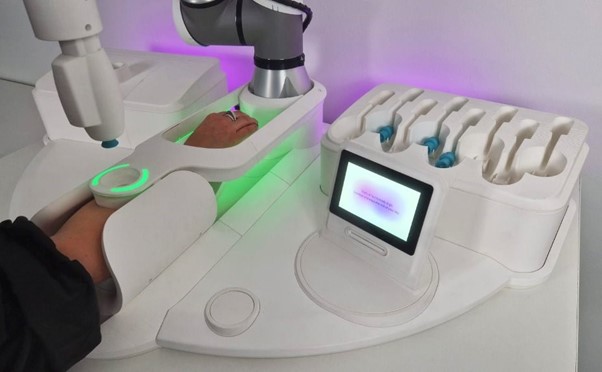ROB:ID – Development of a robotic solution for intradermal vaccination in the skin
Vaccines remain one of the major successes of global health. Several life-threatening diseases can not only be prevented but also treated by vaccination. Additionally, vaccination can be considered the best way to control a pandemic like COVID-19.
However, to be able to cope with current and future health emergencies, continuous work is necessary to improve vaccine and vaccine uptake methods.
Under DIH-HERO and subsequent VLAIO funding, ROB-ID, has been developed by Idevax, Stemberg and Voxdale as a demonstrator to allow for future robotic vaccination.
ROB-ID has the potential to bring a paradigm shift in primary care by supporting further roll-out of vaccination in the pharmacy of the future as well as outbreak and pandemic preparedness plans.
How does ROB-ID work
ROB-ID integrates VAX-ID®, an innovative device offering reliable, accurate and painless skin drug delivery, with a vaccination robot. This solution offers a combination of the accuracy of VAX-ID® with the speed, safety and accessibility of a robot.
The vaccinee journey can be envisioned as follows:
- A vaccinee inserts his/her electronic ID card in the UI/UX. In the tray the prefilled syringes are available for administration and the robot arm is set to ready for use. Through the ID card, the robot will connect to electronic patient records and be linked to vaccine prescriptions.
- The vaccinee will be asked to place his/her arm into the robot arm rest as per indication on the screen after which the vaccination will take place.
- After the injection, the VAX-ID will be disposed into the sharps’ container, the vaccinee can remove his/her arm and the robot arm will prepare for the next vaccinee.
Benefits of using ROB-ID
ROB-ID banks on the unique advantages of VAX-ID and additionally increases speed of vaccination and reduces cost of administration at an enhanced patient and operator friendliness.
The ROB-ID project is revolutionising the vaccination market and addressing an important socio-economic opportunity by ensuring safe, fast, standardised, and adequate robotic vaccination for pandemics and endemics.
A robotic system could also help decrease the workload of pharmacists that offer vaccinations in their pharmacy such as the Flu/COVID in many countries including Belgium. (1)

Some of ROB-ID’s unique propositions include:
- Dose sparing effect – improved immune response, solving vaccine shortages (10% dose) resulting in better heard immunity
- Protects healthcare workers – Robotic vaccination allows for physical distancing and helps to decrease the workload from healthcare professionals as there is no need for elaborate training. This can also allow them for time to focus on patient care
- Solves needle phobia – the injection is very low in pain for the vaccinee, and uses an invisible, short and thin needle, with a clean and controlled penetration motion, resulting in a painless injection and administration, and aids in preventing needle-phobia
- Offers accurate and guaranteed vaccination – ID technology and robotics, allows for increased coverage, making vaccines accessible for everyone
Next Steps
Currently, we are in the process of evaluating our newest prototype, a ROB-ID demonstrator. Several groups have joined forces to bring this project to a success including Idevax, Stemberg, Voxdale, Ghent University and the University of Antwerp.
References:
(1) The-role-of-community-pharmacists-in-vaccination-PGEU-Position-Paper.pdf

